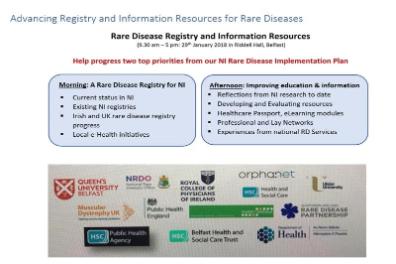Supporting people living and working with rare diseases across NI
Our 2020 communication and information report highlights ten priority recommendations for rare diseases across Northern Ireland.

Communications and Information Review: NI Report for Rare Diseases
Amy Jayne McKnight1,2, Julie McMullan2, Rhoda Walker2, Christine Collins1
1. Northern Ireland Rare Disease Partnership; info@nirdp.org.uk; 2. Centre for Public Health, Queen’s University of Belfast; raredisease@qub.ac.uk; DOI 10.17605/OSF.IO/PUH5B

Rare diseases are characterised by their relatively low prevalence individually, but cumulatively they are common, affecting one in seventeen persons at some point in their lives. It is estimated that 350 million people globally have a rare disease with approximately 110,000 people affected by a rare disease across Northern Ireland. Being diagnosed with a rare disease can lead to a significantly reduced lifespan and quality of life for patients and their families. Patients, carers, health and social care professionals consistently describe challenges accessing accurate information about individual rare diseases and accessing appropriate services. Individuals living with rare conditions often describe feeling ‘isolated’ and ‘dismissed’ so improved communication strategies are urgently required. Improved provision of information has been embedded in many national plans for rare diseases, including the Northern Ireland Rare Disease Implementation Plan.
While there are many charities with dedicated patient advocacy services, members of the rare disease community often struggle without a dedicated charity for their rare disease. Many rare disease patients (or their family or carers) need to source information and promote best care for themselves, without any training in how to do so. They frequently report healthcare professionals and service providers being unfamiliar with their rare disease or relevant rare disease resources for information and support. This report reflects feedback from people diagnosed with rare disease(s), people still searching for a diagnosis, their families, carers, and support teams.
Beyond the initial communications review envisaged in the NI Rare Disease Implementation Plan, information has been developed for healthcare professionals1, patients living with rare diseases (Stronger Together; RARDTAC), and those helping to care for them. However, there is a strong and continued call for a NI Information Hub for Rare Diseases, in the form both of an online guidance tool, and of “a person at the end of a telephone”, to stabilise information provision and provide an element of sustainable coordination for this isolated and fragmented community.

This information and communication report is the culmination of many years research, including many collaborative events to inform contents of this document.
This report provides evidence for ten priority recommendations and ten recommendations for further consideration.
Acknowledgements: We thank all the individuals, patients, families, community groups, health, social, and educational professionals, colleagues, facilities managers, and participants who generously gave their time and shared expertise to develop this document. Your input is much appreciated.

Media
For more information, please do get in touch via email

